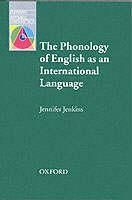OXFORD APPLIED LINGUISTICS: THE PHONOLOGY OF ENGLISH AS AN INTERNATIONAL LANGUAGE OPAL Series
Langue : Anglais
Auteur : JENKINS

This book advocates a new approach to pronunciation teaching, in which the goal is mutual intelligibility among non-native speakers, rather than imitating native speakers. It will be of interest to all teachers of English as an International Language, especially Business English. It proposes a basic core of phonological teaching, with controversial suggestions for what should be included.
Acknowledgements. Introduction. 1. The background: Changing patterns in the use of English. The historical shift. Changing ownership, changing terminology. Appropriate pedagogy for an international language. The EIL phonological problem: where do we go next?. 2. The variation problem 1: Inter-speaker variation. Inter-speaker variation. Inter-speaker segmental variation and its effects. Inter-speaker suprasegmental variation and its effects. 3. The variation problem 2: Intra-speaker variation. L1 and IL intra-speaker variation: a distinction. Phonological intra-speaker variation and its effects on interlanguage talk. 4. Intelligibility in interlanguage talk. What do we mean by intelligibility?. Defining intelligibility in interlanguage talk. Bottom-up and top-down processing. The role of phonology in ILT: miscommunication in the ILT data. Intelligibility and the spread of English. Conclusion. 5. The role of transfer in determining the phonological core. The complex process of L1 phonological transfer. Conclusions: transfer, intelligibility, and teachability. 6. Pedagogic priorities 1: Identifying the phonological core. Establishing the Lingua Franca Core. The origin of the Lingua Franca Core. Features of the Lingua Franca Core. Redefining phonological error and correctness for EIL. 7. Pedagogic priorities 2: Negotiating intelligibility in the ELT classroom. Accommodation theory and intra-speaker variation in ILT. Communicative efficiency and interlanguage. Accommodation and IL repertoire. Accommodating classrooms. 8. Proposals for pronunciation teaching for EIL. An overhaul of pronunciation teaching in English language teacher education. An overhaul of pronunciation testing. Radical improvement in the status of 'NNS' EIL pronunciation teachers. Pronunciation learning for 'native speakers' of Englishalt,br /agt,. Afterword: The future of the phonology of EIL. Bibliography. Index.
Date de parution : 03-2006
23.3x15.7 cm
Thème d’OXFORD APPLIED LINGUISTICS: THE PHONOLOGY OF ENGLISH AS... :
© 2024 LAVOISIER S.A.S.



